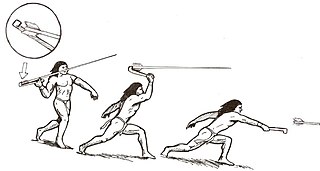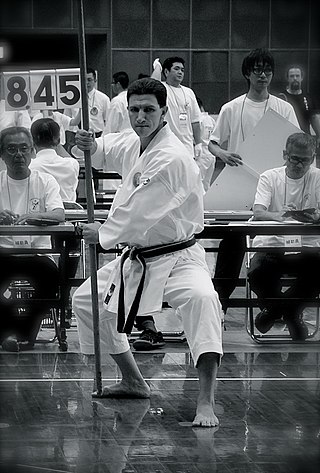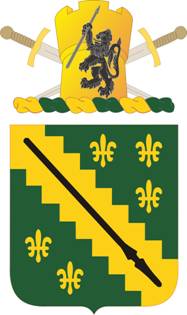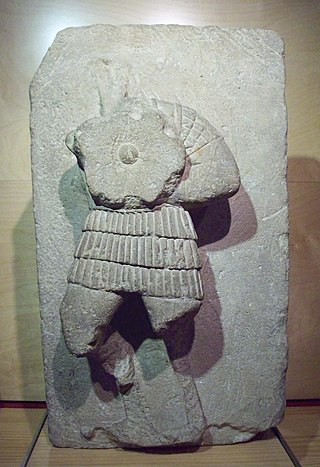A spear is a polearm consisting of a shaft, usually of wood, with a pointed head. The head may be simply the sharpened end of the shaft itself, as is the case with fire hardened spears, or it may be made of a more durable material fastened to the shaft, such as bone, flint, obsidian, copper, bronze, iron, or steel. The most common design for hunting and/or warfare, since ancient times has incorporated a metal spearhead shaped like a triangle, diamond, or leaf. The heads of fishing spears usually feature multiple sharp points, with or without barbs.

The tonfa is a melee weapon with its origins in the armed component of Okinawan martial arts where it is known as the tunkua. It consists of a stick with a perpendicular handle attached a third of the way down the length of the stick, and is about 15–20 inches (380–510 mm) long. It was traditionally made from red or white oak, and wielded in pairs. The tonfa is believed to have originated in either China, Okinawa or Southeast Asia, where it is used in the respective fighting styles.

A spear-thrower, spear-throwing lever, or atlatl is a tool that uses leverage to achieve greater velocity in dart or javelin-throwing, and includes a bearing surface that allows the user to store energy during the throw.

A bō (棒) is a staff weapon used in Okinawa. Bō are typically around 1.8 m (71 in) long and used in Okinawan martial arts, while being adopted into Japanese arts such particular bōjutsu. Other staff-related weapons are the jō, which is 1.2 m (47 in) long, and the hanbō, which is 90 cm (35 in) long.

The sarissa or sarisa was a long spear or pike about 5 to 7 meters in length. It was introduced by Philip II of Macedon and was used in his Macedonian phalanxes as a replacement for the earlier dory, which was considerably shorter. These longer spears improved the strength of the phalanx by extending the rows of overlapping weapons projecting towards the enemy. After the conquests of Alexander the Great, the sarissa was a mainstay during the Hellenistic era by the Hellenistic armies of the diadochi Greek successor states of Alexander's empire, as well as some of their rivals.

The tanbō is a short staff weapon used in Okinawa and feudal Japan. Today the tanbō is used by various martial arts schools.

The francisca was a throwing axe used as a weapon during the Early Middle Ages by the Franks, among whom it was a characteristic national weapon at the time of the Merovingians. It is known to have been used during the reign of Charlemagne (768–814). Although generally associated with the Franks, it was also used by other Germanic peoples of the period, including the Anglo-Saxons; several examples have been found in England.

The MG 131 was a German 13 mm caliber machine gun developed in 1938 by Rheinmetall-Borsig and produced from 1940 to 1945. The MG 131 was designed for use at fixed, flexible or turreted, single or twin mountings in Luftwaffe aircraft during World War II. It was also license-built in Japan for the Imperial Japanese Navy as Type 2 machine gun.

Okinawan kobudō (沖縄古武道), literally "old martial way of Okinawa", is the weapon systems of Okinawan martial arts.

The collared reed snake is a species of colubrid snake found in Asia. In Japan, it is also called Miyara's collared snake.

Acacia melanoxylon, commonly known as the Australian blackwood, is an Acacia species native to south-eastern Australia. The species is also known as blackwood, hickory, mudgerabah, Tasmanian blackwood, or blackwood acacia. The tree belongs to the Plurinerves section of Acacia and is one of the most wide-ranging tree species in eastern Australia and is quite variable mostly in the size and shape of the phyllodes.

The tekkō, are weaponized stirrups and horseshoes which originated in Okinawa, Japan, and they fall into the category of "fist-load weapons". By definition, a fist-load weapon increases the mass of the hand so that, given the physical proportionality between the fist's momentum and its mass, it increases the force the bearer can deliver. Some fist-load weapons may also serve, in the same manner, as the guard on a sword, to protect the structure of the bearer's hand.

The surujin or suruchin is one of the traditional weapons of Okinawan Kobudo. It comprises a 150 -152 cm or 2-3(4,921 feet -4,986 feet or 6,5 feet -9.8feet) long rope with a weight tied to each end. Historically this weapon is very prevalent and can be found attached to a weapon or used separately. It is a weapon designed for warfare.
Ryukyu Kobudo is the branch of Okinawan Kobudo developed and systemized by Taira Shinken under the Ryukyu Kobudo Hozon Shinko Kai association.
Seikichi Odo, whose name means "world walker" in Japanese, was a karateka. He combined kobudō and karate techniques to found the Ryūkyū Hon Kenpo Kobujutsu Federation.
Shinpo Matayoshi was a martial artist who lived in Naha, Okinawa, during the 20th century.

Illyrian weaponry played an important role in the makeup of Illyrian armies and in conflicts involving the Illyrians. Of all the ancients sources the most important and abundant writings are those of Ennius, a Roman poet of Messapian origin. Weapons of all sorts were also placed intact in the graves of Illyrian warriors and provide a detailed picture for archaeologists on the distribution and development of Illyrian weaponry.

The 71st Cavalry was originally constituted on 3 December 1941 in the Army of the United States as the 701st Tank Destroyer Battalion.

The 38th Cavalry Regiment was a regiment of the United States Army first established in 1916. It was the regimental affiliate of three reconnaissance and surveillance squadrons that were part of battlefield surveillance brigades.

Caetra was the shield used by Iberian, Celtiberian, Gallaecian and Lusitanian warriors. The shield was circular shaped with a diameter between 30 cm to 90 cm. It was tied to the warrior's body with ropes or leather strips that passed over the shoulder and that gave great mobility to fight both on foot and on horseback. The shapes and decorations of the shields had variations in their metal, wood or leather protection. Warriors that carried this shield were usually light infantry called caetratus.

















